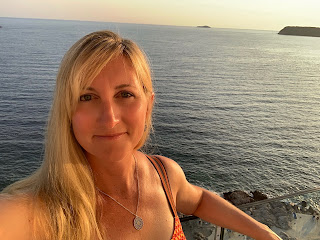Sue Fliess is the author of the new children's picture books Beauty and the Beaker and Kid Scientist: Zoologists on the Trail. Her many other books include Octopus Acrobatics. She lives in Northern Virginia.
Q: What inspired you to write Beauty and the Beaker, and how did you create your character Beauty?
A: My publisher wanted another fractured fairytale, so I started brainstorming with a list of existing fairytales. I first thought of something with Snow White, then Beauty and the Beast, which I thought could be Beauty and the Beach. And it could have an ocean conservation angle.
But then–and it’s always good to have creative friends!--my friend Julie Hedlund emailed me and said I thought of a title and you are the one to write the book for it: Beauty and the Beaker. Of course, I thanked her profusely and wished I’d thought of it myself, but that is how it goes sometimes!
But then I had the challenge of creating a story around this Beauty. What would she do with her beaker? I’d already been thinking about something with a body of water, so I started researching what types of things she might collect from the ocean, or lakes, or ponds.
When I started reading about algae, both my husband and my scientist/librarian friend suggested I look into biofuels. So, it really takes many minds to pull a story together.
I always want my characters in these STEM fairytales to solve a problem, or create something fantastic, so I had Beauty live on an island, the cyclone is the beast, and she discovers a biofuel through harvesting algae to power her town.
Q: What do you hope kids take away from the story?
A: Stay curious, try new things, research can be fun, dream big and don’t be afraid to fail. And, because the story is based on real science, maybe they’ll be inspired to find help our planet like Beauty did, and learn something too!
Q: You also have another new picture book, Kid Scientist: Zoologists on the Trail. What's the story behind that book?
A: In Zoologists on the Trail, a group of zoologists are returning to Yellowstone National Park to observe a pack of wolves that were introduced there years before. They are watching to see if the pack is healthy, has grown, and to check on the surrounding environment/habitats.
When they arrive, they learn that two of the wolf tracking collars are broken, and decide to track them using bioacoustics instead. This means they howl at the pack, then record the wolf pack’s responding howls. Each wolf has an individual howl, so they can tell if the pack has more members, and can count them.
Q: What do you think the illustrations, by Petros Bouloubasis and Mia Powell respectively, add to the books?
A: Petros has a way with drawing quirky characters that are still impossibly cute. Beauty may just be my favorite! He also adds such wonderful details. Some I notice on the fourth or fifth read, for the first time. There is always so much to look at.
Mia’s artwork has a wonderful playfulness about it, so the characters are very sweet and relatable. This also lets the reader focus on the core information in the book, while still enjoying the great color palette and details in the illustrations.
Q: What are you working on now?
A: I’m working on finishing a middle grade manuscript, reviewing some artwork for a picture book I have coming out next year with author and friend Ann Marie Stephens called So Many Books!, and also fine-tuning some board book pitches.
--Interview with Deborah Kalb. Here's a previous Q&A with Sue Fliess.



No comments:
Post a Comment